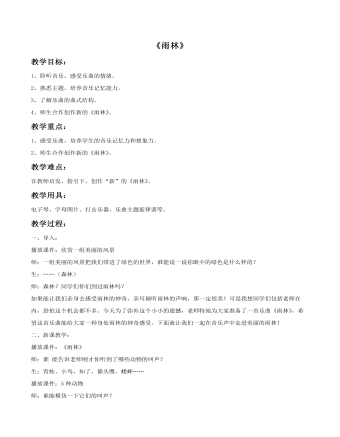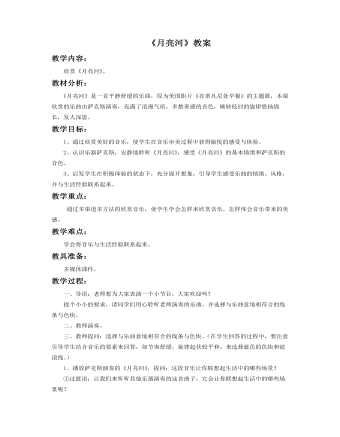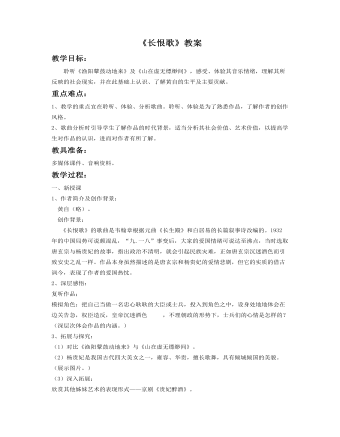-

《雨林》教案
教学过程:一、导入:播放课件:欣赏一组美丽的风景师:一组美丽的风景把我们带进了绿色的世界,谁能说一说你眼中的绿色是什么样的?生:……(森林)师:森林?同学们你们到过雨林吗?如果能让我们亲身去感受雨林的神奇,亲耳倾听雨林的声响,那一定很美!可是我想同学们包括老师在内,恐怕这个机会都不多。今天为了弥补这个小小的遗憾,老师特地为大家准备了一首乐曲《雨林》,希望这首乐曲能给大家一种身处雨林的神奇感受。下面就让我们一起在音乐声中走进美丽的雨林!二、新课教学:播放课件:《雨林》师:谁 能告诉老师刚才你听到了哪些动物的叫声?生:青蛙、小鸟、知了、猫头鹰、蟋蟀……播放课件:5种动物师:谁能模仿一下它们的叫声?生:……播放课件:乐曲与作者的简介师:《雨林》这是一首数码音乐作品,采用清新明快的旋律为主题,加入森林中各种鸟鸣,构成一部有现代意味的雨林。鸟虫的鸣叫,动物的声息是在原始森林中采录的。师:下面我们再来回忆一下,这首乐曲的主要演奏乐器有哪些?

《月亮河》教案
教学过程:一、导语:老师想为大家表演一个小节目,大家欢迎吗?提个小小的要求,请同学们用心聆听老师演奏的乐曲,并选择与乐曲意境相符合的线条与色块。二、教师演奏。三、教师提问:选择与乐曲意境相符合的线条与色块。(在学生回答的过程中,要注意引导学生结合音乐的要素来回答,如节奏舒缓,旋律起伏较平和,来选择蓝色的色块和波浪线。)1、播放萨克斯演奏的《月亮河》,提问:这段音乐让你联想起生活中的哪些场景?①过渡语:让我们来听听其他乐器演奏的这首曲子,它会让你联想起生活中的哪些场景呢?②提问③评价和总结学生的回答。(在学生回答的过程中,要求学生不能单纯地说一个生活场景,而要同过乐曲的音色、速度、力度等音乐要素来展开合适的想象。)2、播放萨克斯演奏的《月亮河》,提出问题:为乐曲起名。①过渡语:这么美的乐曲,一定要有美的名字来配它,让我们一起在音乐声中好好想想,为它取个美丽的名字吧!②提问。③评价和总结学生的回答:这首优美的乐曲,有一个浪漫的名字——MOON RIVER 月亮河。(多媒体出示)3、介绍萨克斯并演奏①过渡语:刚才的乐曲主要是由什么乐器演奏的?老师带来了一个三年级的小同学,他想为你们介绍他的萨克斯,欢迎吗?②学生介绍萨克斯。③学生演奏萨克斯《月亮河》,教师提出要求:观众听得越投入,表演者也会更加投入的,所以请大家随着音乐投入地动起来吧!

《智斗》教案
教学过程:一、组织教学。让学生在京剧的音乐中进入教室(动作可自由。)二、导入。1、老师让学生唱一唱上一节课的《唱脸谱》并且说出歌曲中有几种脸谱及各种脸谱的特点(多媒体同时播放一段京剧,让学生注意京剧中的脸谱、行头、人物的动作、表情等。)2、老师、同学们:你们对京剧知道多少?(学生畅所欲言)京剧是中国的国粹。特别是脸谱、服装等,是中国物质文化的宝贵遗产。你们喜欢吗?三、欣赏感受。(一)《包龙图打坐在开分那府》。1、老师出示脸谱问:同学们刚才你们看到这个脸谱吗?代表什吗?(正义,铁面无私)常用来代表谁?(包公、张飞。)2、师:对他们都是正义的象征,今天咱们讲一个关于包公的故事。(先简介一下《铡美案》的剧情,激起同学的愤慨。师:咱们先看一下包公是怎样对待忘恩负义的陈世美的?3、大屏幕放录音唱段,老师提出问题,哪部分情绪激昂,哪部分节奏舒缓。(先照对歌词,有助于学生对唱词的理解。)放录音第二遍,师生互填表。4、拓展延伸。让学生舒一下情怀,假如你遇到如此情况,是刚正不阿主持正义,还是顺水推舟做个人情?(学生自由议论,热烈发言。)

《长恨歌》教案
教学过程:一、新授课1、作者简介及创作背景:黄自(略)。创作背景:《长恨歌》的歌曲是韦翰章根据元曲《长生殿》和白居易的长篇叙事诗改编的。1932年的中国局势可说颇混乱,“九.一八”事变后,大家的爱国情绪可说达至沸点,当时选取唐玄宗与杨贵妃的故事,指出政治不清明,就会引起民族灾难,正如唐玄宗沉迷酒色而引致安史之乱一样。作品本身虽然描述的是唐玄宗和杨贵妃的爱情悲剧,但它的实质的借古讽今,表现了作者的爱国热忱。2、深层感悟:复听作品;模拟角色:把自己当做一名忠心耿耿的大臣或士兵,投入到角色之中,设身处地地体会在边关告急,权臣造反,皇帝沉迷酒色,不理朝政的形势下,士兵们的心情是怎样的? (深层次体会作品的内涵。)3、拓展与探究:(1)对比《渔阳鼙鼓动地来》与《山在虚无缥缈间》。(2)杨贵妃是我国古代四大美女之一,雍容、华贵,擅长歌舞,具有倾城倾国的美貌。(展示图片。)(3)深入拓展:欣赏其他姊妹艺术的表现形式——京剧《贵妃醉酒》。4、在黄自的《踏雪寻梅》中结束本课。

《智斗》教案
教学过程:(一)导入新课。1、欣赏歌曲《唱脸谱》。设问:刚才我们听到的歌曲与以往听到的歌曲有什么不同?你在什么地方听到过京剧?你知道哪些关于京剧的知识?导入:京剧是我国的国粹,迄今已有200多年的历史。它是第一个走向国际舞台的,代表中华民族的表演艺术。所以我认为作为中国人,有必要了解一下自己的国宝——我们的京剧艺术。(二)新课教学。1、欣赏京剧《智斗》(现代京剧《沙家浜》选段)。a。简介人物身份、故事情节后听赏《智斗》。b。这三个人物之间的关系?这三个人物在剧中的性格形象分别有什么特点?(1)唱腔:西皮。反西皮 :是[西皮]声腔的一种曲调,它是从[西皮]正调中演生出来的。是正[西皮]的反调,即向下四度发展转化而成。[反西皮]和[西皮]一样大多是"眼起板落",开唱在眼上,末句落在板上。请注意:[反西皮]的下句落音往往是低音5和中音1,和[西皮]相比,音调较低沉,常常用于表现人物内心思索的过程。(2)板式:摇板(紧拉慢唱)。流水板(一拍子):流水板就是一种形似流水一样的板式,节奏比较快,但不是像波涛滚滚的长江那样跌宕起伏,而是像水流平缓的涓涓小溪,用快而不急的节奏,把人物的内心感情抒发出来,多用于对事物的叙述和自我表白。比流水板节奏更加快的,则是“快板”。快板用于剧中人物异常激动,或事态急剧变化,或矛盾瞬间变得激烈时,往往把剧情引向高潮。

《鳟鱼》教案
教学过程一、组织教学师生问好!二、导入新课观察鳟鱼图片,由图片导入课题。师:同学们请看图片,有没有同学知道是什么鱼?(鳟鱼,很有价值的垂钓鱼,可食用,全世界只有十多种。)我们今天欣赏的音乐与这种鱼有关,是一首以鳟鱼来命名的音乐。有同学可能会说:“谁会去描写这种看起来并不漂亮甚至还有些凶的鱼呢?”优秀的艺术家,任何素材都可以来来创作,我们现在开始学习《鳟鱼》。三、新课教学1、认识舒伯特。舒伯特(1797年1月31日-1828年11月19日),奥地利作曲家,出生于维也纳。自幼随父兄学习小提琴和钢琴。舒伯特的一生是在贫困中度过的,艰难的生活使他过早地离开人世。然而,舒伯特却为人类留下了大量的不朽名作,被称为“歌曲之王”。在短短31年的生命中,创作了600多首歌曲,18部歌剧、歌唱剧和配剧音乐,10部交响曲,19首弦乐四重奏,22首钢琴奏鸣曲,4首小提琴奏鸣曲以及许多其他作品。

《鳟鱼》教案
教学目标:1、通过欣赏,学生能听出音乐的段落之间情绪,力度,音色等音乐元素的变化,并根据这些变化,感受音乐描述的情绪和内容,辅以简单动作表现。2、通过欣赏,学生知道了钢琴五重奏这种演奏形式,对其组成乐器有一定认识。3、了解与作品相关的背景知识,激发学生欣赏古典音乐的兴趣,感受古典音乐的魅力。教学重难点重点:学生能听出音乐的段落之间情绪,力度,音色等音乐元素的变化,对音乐内容有大体了解。难点:通过演唱,动作等形式,加强对音乐的感受。教学准备:相关的音频视频资料,ppt课件,钢琴教学过程:一、导入给同学播放三段音乐,请同学说一说听过这几段音乐的感受,并且他们都是用什么乐器演奏的 (小提琴)二、欣赏主题1、播放《鳟鱼》主题音乐,请你听一听它的情绪是怎样的,并且你听到它主要是用什么乐器演奏的。(欢乐的,悠闲的……小提琴)2、老师为这段音乐加上主人公和环境,(鳟鱼。流动的河水,阳光)请结合着这些人物环境,和你刚刚听到的音乐的情绪,再次听音乐,你脑海中浮现出一幅怎样的画面,用你最优美的语言告诉老师。

《昨日》教案
教学过程:一、导入同学们,你们知道“甲壳虫”吗?The Beatles(披头士,又译甲壳虫乐队)毫无疑问是流行音乐界历史上最伟大,最有影响力,最为成功的乐队。The Beatles对于流行音乐的革命性的发展与影响力无人可出其右,对于世界范围内摇滚的发展做出了非常巨大的贡献,影响了自60年代以后的数代摇滚乐队的音乐和思想,直接影响了摇滚乐的变革和发展,在英国,披头士乐队更是影响了60年代至今几乎每一支乐队的形成和发展。而乐队中四名伟大的音乐家,特别是约翰列侬和保罗麦卡特尼,对于世界各个角落的后辈摇滚歌手及音乐创作者们的影响持续至今。二、新课教学1、播放《昨日》初次聆听,谈谈你的感受。2、简介歌曲来源及故事背景歌曲《Yesterday》创作过程据麦卡特尼忆述,歌曲旋律的灵感来自梦中,一觉醒来后他立即走到钢琴前弹奏出来,并以录音机记录下来。歌曲一经发行,就引起了强烈的反响,优美的旋律,隽永的歌词,刻画出每个人心灵深处那失落在时间中的影子。不论文化背景、社会地位、审美取向,甚至是否爱好音乐,几乎人人都会被这首歌打动,它真正做到了雅俗共赏。

《鳟鱼》教案
教材分析:1、作品分析:《鳟鱼》是舒伯特1817年根据诗人舒巴尔特的浪漫诗创作的一首艺术歌曲。它以叙述式的手法向人们揭示了善良和单纯往往被虚诈和邪恶所害,借对小鳟鱼不幸遭遇的同情,抒发了作者对自由的向往和对迫害者的憎恶,是一首寓意深刻的作品。2、作者介绍:舒伯特(1797---1828)奥地利作曲家,欧洲浪漫乐派的代表人物之一。由于生活贫困又不愿依附于权贵,在他的作品中常常流露出苦闷和压抑的情绪,年仅31岁就离开了人世。舒伯特的创作体裁非常广泛,包括歌剧、交响乐、重奏乐、奏鸣曲等,其中歌曲是舒伯特有特殊成就的创作领域,被誉为“歌曲之王”。3、作品结构图(略)4、重奏乐:又称之为室内乐,17世纪起源于意大利。近代室内乐指每一声部都由一件乐器演奏的小型合奏曲。按声部人数的多少可分为“二重奏”、“三重奏”等,也可按演奏的乐器分为“铜管重奏”、“木管重奏”等,其中最常见的形式是弦乐四重奏,分别由两把小提琴、一把中提琴和一把大提琴组成。5、变奏曲式:由代表基本乐思的音乐主题及若干变奏所构成的曲式,称为变奏曲式,变奏中最初的呈现并作为以后变奏所依据的原型部分,称为变奏的主题,其后的各次变奏依次称为变奏一、变奏二、变奏三……结构图式为A+A¹+A²+A³……6、常见变奏手法:改变演奏、演唱方式:加入各种装饰音;改变音色、速度、力度、节奏、调号等。

初中历史与社会人教版九年级下册《地球一小时 活动》教材教案
地球一小时(Earth Hour)是世界自然基金会(WWF)应对全球气候变化所提出的一项倡议,希望家庭及商界用户关上不必要的电灯及耗电产品一小时。来表明他们对应对气候变化行动的支持。过量二氧化碳排放导致的气候变化目前已经极大地威胁到地球上人类的生存。公众只有通过改变全球民众对于二氧化碳排放的态度,才能减轻这一威胁对世界造成的影响。地球一小时在3月的最后一个星期六20:30~21:30期间熄灯。活动由来:“地球1小时”也称“关灯一小时”,是世界自然基金会在2007年向全球发出的一项倡议:呼吁个人、社区、企业和政府在每年三月最后一个星期六20:30~21:30期间熄灯1小时,以此来激发人们对保护地球的责任感,以及对气候变化等环境问题的思考,表明对全球共同抵御气候变暖行动的支持。这是一项全球性的活动,世界自然基金会于2007年首次在悉尼倡导之后,以惊人的速度席卷全球,大家都来参加这个活动。[1] “地球1小时”活动首次于2007年3月31日在澳大利亚的悉尼展开,一下子吸引了超过220万悉尼家庭和企业参加;随后,该活动以惊人的速度迅速席卷全球。在2008年,WWF(中国)对外联络处透露,全球已经有超过80个国家、大约1000座城市加入活动。2013年,包括悉尼歌剧院、帝国大厦、东京塔、迪拜塔、白金汉宫在内的各国标志性建筑也在当地时间晚八点半熄灯一小时。[2] ,其中包括巴勒斯坦、法属圭亚那、加拉帕戈斯群岛、卢旺达、圣赫勒那岛、苏里南、突尼斯等首次参与“地球一小时”的国家和地区。在中国,北京鸟巢、水立方、世贸天阶等标志性建筑同时熄灯,同一时段,从上海东方明珠到武汉黄鹤楼,从台北101到香港天际100观景台,中国各地多个标志性建筑均熄灯一小时,全国共有127个城市加入“地球一小时”活动。

人教版新目标初中英语七年级下册Where is the post office教案2篇
Period 2 (3a----Section B 2c)Preview(Pre-task): Key points: What laAdd another information about their pen pals----their language on the cardnguage does she/he speak?She/He speaks....Does she/he have any brothers and sisters? Does she/he speak English?Preview(Pre-task): Add another information about their pen pals----their language on the cardKey points: What language does she/he speak?She/He speaks....Does she/he have any brothers and sisters? Does she/he speak English?Step 1 Revision1.Revisionand dictation of the new words 2.Revise the drills they learned yesterday.(by pairwork and grammar exercise)Step 2 Leading-inT has a conversation with one student. The conversation is following:---Do you have a pen pal?---Yes, I do.---What's your pen pal's name? ---His/Her name is....---Where is your pen pal from? ---He/She is from...---Where does he/she live? ---He/She lives in....---What language does he/she speak?He/She speaks...Write the new words on the Bb. They are following: EnglishChineseJapaneseFrenchStep 3 LearnLearn the new words with the whole class.Finish 3a with the students3b Pairwork T still does an example with one student Then the Ss practise in pairs. The example is following:--Curry Muray is my pen pal. He is from the United States.---What language does he speak?

人教版新目标初中英语七年级下册I want to be an actor教案2篇
三、教学建议第一课时:1. Lead in (Vocabulary)A) Before class, teacher should collect some pictures of working places. For example: Bank, TV Station, Restaurant, Police Station, Hospital ...B) In class, show students the pictures (PowerPoint, OHP). Ask students to tell the name of the working places and the name of the jobs.Shop assistant, doctor, actor, reporter, police office, waiter, bank clerk, studentC) Do exercise 1a and 3a.2. Bingo GameAsk groups of students to make up pairs of cards with a job on one and the related workplace on the other. For example, waiter / restaurant, teacher / school, doctor / hospital. Encourage students to use both the job / workplace combinations in the book and the ones that students came up during class discussions. Be sure they have twice as many sets of cards as there are students in the group. They can make two sets of cards for a single job / workplace, if necessary. Then have each group mix up its set of cards and hand their cards out in random order. Each time a student gets a pair of cards that match, he or she can lay these cards down. The goal is to have no cards in your hand at the end.3. Task OneA) Ask students to work in pairs and ask the partner what does he / she want to be in the future.e. g. :What do you / does he / does she want to be?I want to be a.Why?Because it's (adj).B) Vocabulary: Section B, 1a4. Homework 1.2.

人教版新目标初中英语七年级下册It’s raining教案2篇
1 Each group choose one place to describe and what you are doing in it Choose one place, and describe what they are doing 2 Move around the room and give suggestions Talk about it and write it down 3 Ask one to show their works and act it Choose one of each group to make a report 4 Evaluate the best group and the best reporter Choose the best one Homework Ask your friends their ideal place and write about it教学反思:新课程标准中强调学生在课堂中的主体地位,在综合课中他们的主体地位就更加突出。在各个活动中给不同程度的学生不同层次的任务,让各层面的学生都有表现发挥的机会,从而产生对英语的兴趣。使用照片图片多媒体来辅助教学,效果更好。同时让了解其他国家风景,风俗的同学介绍ideal place,增加学生的背景知知识,实现跨学科交流的目的。教案点评:采用任务型教学模式,在各个活动中给不同程度的学生不同层次的任务,让各层面的学生都有表现发挥的机会,从而产生对英语的兴趣。使用照片图片多媒体来辅助教学,效果更好。让了解其他国家风景,风俗的同学介绍ideal place,增加学生的背景知识,实现跨学科交流的目的。

人教版新目标初中英语七年级下册Why do you like koalas教案2篇
单元整体说明(一)单元教材分析本单元的核心话题是描述动物和表达个人喜好,以及句式why do you like…? Because…。这也是本单元的教学重点。通过本单元的学习,学生应能较流利地运用所学词汇和句型描述动物,表达个人喜好。(二)单元知识结构1.词汇动物名称 tiger, elephant, koala, dolphin, etc.词汇描述性形容词: smart, cute, ugly, clever, shy, etc.国家名: Australia, South Africa2.句型Why do you like koala hears? Because they are cute.Where are pandas from? They're from China.What animals do you like? I like dolphins.(三)单元整体目标1.Master the vocabulary2.Master and use: Why do you like koalas? Because they am cute.Where are pandas from? They're from China.What animals do you like? I like dolphins.(四)单元教学重难点一览(五)单元学情分析学生此前已经学过由why, where, what 引导的特殊疑问句句型,具有了学习本单元知识的认知前提。形形色色的动物能激发学生的好奇心,产生了解它们的欲望,这有利于本单元知识的教学和学生学习兴趣的培养。

人教版新目标初中英语八年级上册How do you make a banana milk shake教案2篇
1. First, ... then, ... next, ... finally, ...首先,……然后,……接着,……最后,……这是英语中表达做某事的步骤的一种说法。如果步骤较多,还可以说:first-next-after that-later on-finally/at last通常你会听到说英语国家的人在说 first, next, then, finally 和后面的内容时,他们会做一些停顿。这样就能提前告诉听者接下来讲的是一系列的步骤。这一点在朗读和听力中应特别注意。2. how many, how much均为疑问词,同是“多少”,但用法不同。请看:how many修饰可数名词复数,how much修饰不可数名词。但在用法上,同学们常犯如下错误:1) [误] How many are there bananas on the table?[正] How many bananas are there on the table?[析] how many, how much 中的many,much是形容词,常修饰名词作定语,故后面跟名词。2) [误]How much tea are there on the table?[正]How much tea is there on the table?[析] how much修饰不可数名词时,谓语动词用单数。how many与how much的区别可简记为:前how many:问“多少”,复数名词后面跑;how much问“多少”,不可数名词单数好。前者答语用基数词,后者答语用数量关系。

人教版新目标初中英语八年级上册How do you get to school教案2篇
Step Ⅶ Role play ( Work on 1b)1. First ask two students to read the dialogue to the class.Sa: How do you get to school?Sb: Well, I ride my bike to the subway station. Then I take the subway.2. Now work with a partner.Suppose you use two kinds of transportation to get to school \Hangzhou\Beijing... (bus, train, subway, walking, bike, etc.) Tell how you get there. You may use the phrases in 1a.3. Then ask different pairs of students to present their conversations to the class.Step ⅧListening1. Work on 2a(1) First ask students to read the list of information that Thomas wants to know.…where Nina lives.…how far from school she lives.…how long it takes to get to school.…how she gets to school.…what she thinks of the transportation.(2) Tell students what transportation and bus stop mean.bus stop 汽车站 transportation n. 运送;运输Then tell students we'll hear a recording. Please put a checkmark in front of each thing that Thomas wants to know.(3) Now play the recording for students.( Have students pay attention to the sample answer.) (4) Then correct the answers.

人教版新目标初中英语八年级上册I’m more outgoing than my sister教案2篇
1 交通工具的比较此活动为小组活动。学生通过讨论找出到达某一城市可乘坐的各种交通工具,并选择最佳出行方式。Teacher:We’re going to Shanghai. How many ways can we use to get there? Yes, there are four ways: by bus, by plane, by train, by ship. Please discuss how you are going to get there.操作建议:(1)学生以小组为单位展开活动,谈论本组所选择的交通工具。(2)各组选代表向全班汇报,阐述本组所选择的交通工具的利和弊。完成任务所需要的语言结构:We can go there by ship. It’s more comfortable and cheaper than any other transportation.We can go there by bus. It’s cheaper but it takes longer time.2 哪个城市更合适?此活动具有挑战性。假设中国要举行2014年世界杯足球赛,分别从历史,人文,天气等方面对各城市(北京,大连,上海,昆明)进行比较,选择最佳举办城市。T: Imagine China is holding the 2014 FIFA World Cup. Which city do you think is the best for the World Cup, Beijing, Dalian, Shanghai or Kunming? Let’s work in groups. If you choose Beijing, please join the Team Red. If you chose Dalian, please join the Team White. If you choose Shanghai, please join the Team Blue. If you choose Kunming, please join the Team Green. Please show us its advantages. Then let’s see which team will win.

人教版新目标初中英语八年级上册What’s the matter教案2篇
She shouldn’t go to the party tonight.Step7. TaskT: You know, there are lots of problems in our life. If you are a doctor, please tell us how to solve the problem. I will divide you into 9 groups. Please work in groups. And then choose one of you to report your ideas.The following are the problems:I have a toothache.I am hungry. I have a sore throat.I am stressed out. I have a sore back.I am tired. I can’t sleep.I have a cold. I have a headache.Report: If you have a headache, you should go to bed early. You should see the doctor. You should eat some medicine. You shouldn’t wash your face with cold water.You shouldn’t sleep late.You shouldn’t swim.…..T encourages the students to give advice as much as possible.Homework:1. Chose one of the problems, and write down your advice2. Copy the new words这一步是用于热身的,同时也可以让他们复习一部分的表示人体部位的单词,扩充知识.学习语言的过程也是一个不断积累的过程,复习旧知识,增添新知识.通过小游戏,强化学生对Does she/he have…这个句子的运用能力.通过复习,自然的引到下面新知识的学习。充分利用表格,由句子到对话,再到文章,让学生循序渐进. 提高学生的综合语言运用能力,运用以前学过的知识来解决身边的问题.Period 5 (Section B 3a—3c, selfcheck)教学内容与分析:

人教版新目标初中英语八年级下册If you go to the party, you’ll have a great time教案2篇
区分宾语从句、定于从句和状语从句宾语从句和状语从句,都叫做主从复合句。宾语从句主要是中考必考的,是初中阶段必掌握的从句,宾语从句主要是掌握三要素,所谓宾语从句,就是宾语在主从复合句当中充当宾语的一个句子,叫做宾语从句。主句的谓语动词是及物动词,后面如果是词或者是短语的话,是简单句,如果是句子的话,肯定是宾语从句。I know that he good at English.就是宾语从句,三要素,一要素是要注意连词,连词一共学了三类连词,一类连词是that口语当中可以省略,就像刚才说的那一句,I hear he is good at English.还有疑问代词、疑问副词,how where when,疑问代词、疑问副词。还有一类连词weather是否的意思,不是状语从句当中的如果,这一定要和如果区分开,这是是否。I don't know if he interested at English。宾语从句要注意if是连词。第二要素是语序,要用陈述举语序。比如说你家有几口人,我们都说How many people are there in you family?但是这是简单句,一旦说成宾语从句,你可以告诉我你家有几口人吗?Could you tell me how many people there are in you family ?

人教版新目标初中英语八年级下册It’s a nice day, isn’t it教案2篇
"Hello! Welcome to English class! Introduce yourself. Meet your new classmates." That's what the teacher says. What do you say? "Oh no!" It can be difficult talking to new people. But it can be fun, and you can make friends. How do you do it? Make small talk. Small talk is polite conversation. "Wang Nan is a great pingpang player, isn't she?" "I'd love to meet her, wouldn't you?" "It's been raining a lot, hasn't it?" Tag questions are a form of polite speech. To make small talk successfully, you should know how to make them. You should also know what topics to talk about. Try to learn this unit carefully. The next time you're in English class, you'll find out. Making small talk's easy, isn't it? (“你好!欢迎你!请做一下自我介绍。认识一下你的新同学。”通常在课上老师会这样说。你会说什么呢?“噢,不!”与陌生人谈话太困难了。但是这也很有意思,并且你还能交到朋友。你该怎么做呢?闲聊。闲聊指得是礼貌的对话。“王楠是一个很棒的乒乓球运动员,不是吗?”“我希望自己能认识她,你呢?“今年的雨水很多,不是吗?”反意疑问句是一种礼貌用语。为了使得谈话成功,你应该知道怎样去进行闲聊。你还应该知道与不同的人该谈论什么样的话题。认真的学习这个单元吧,下次在英语课上,你会发现与大家展开谈话是一件很容易的事情,不信我们来试试。)

